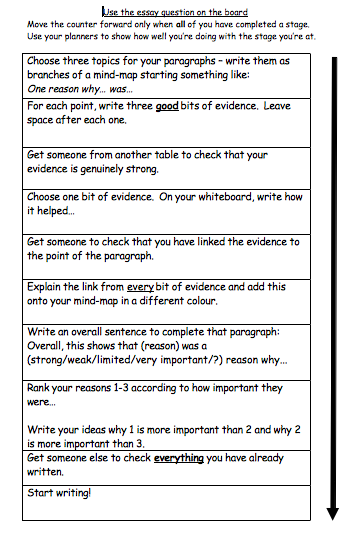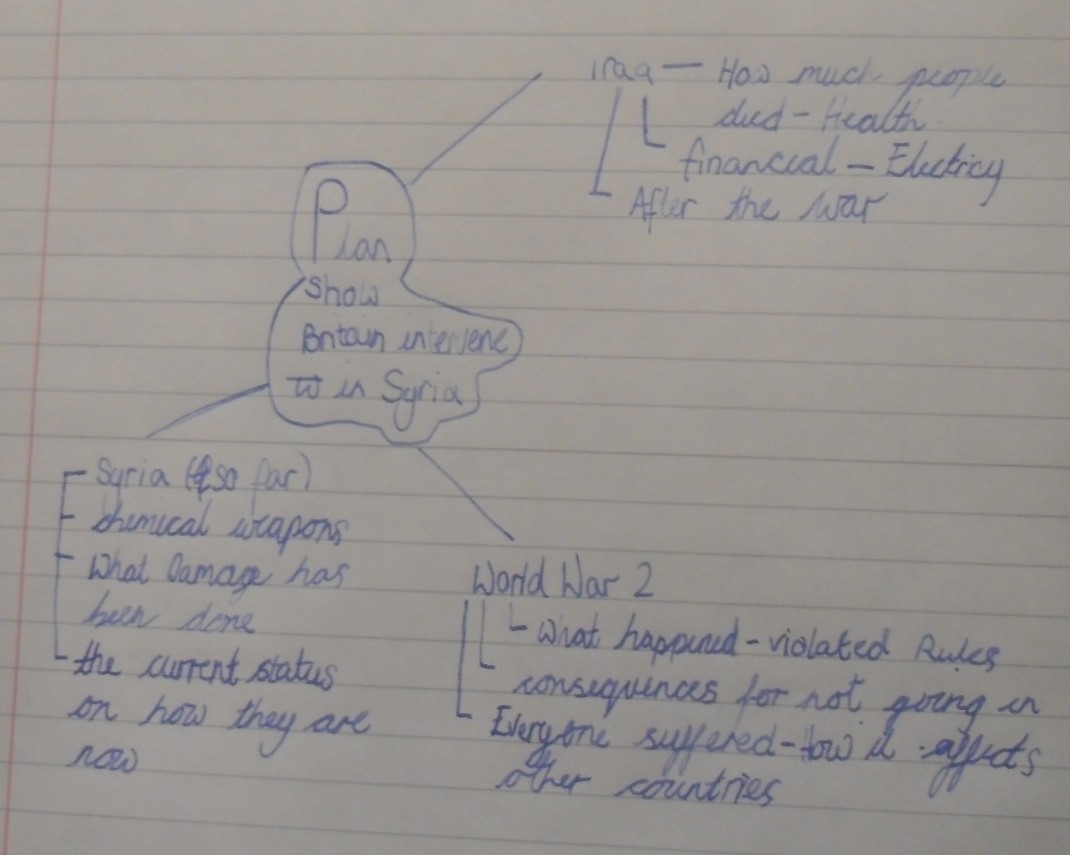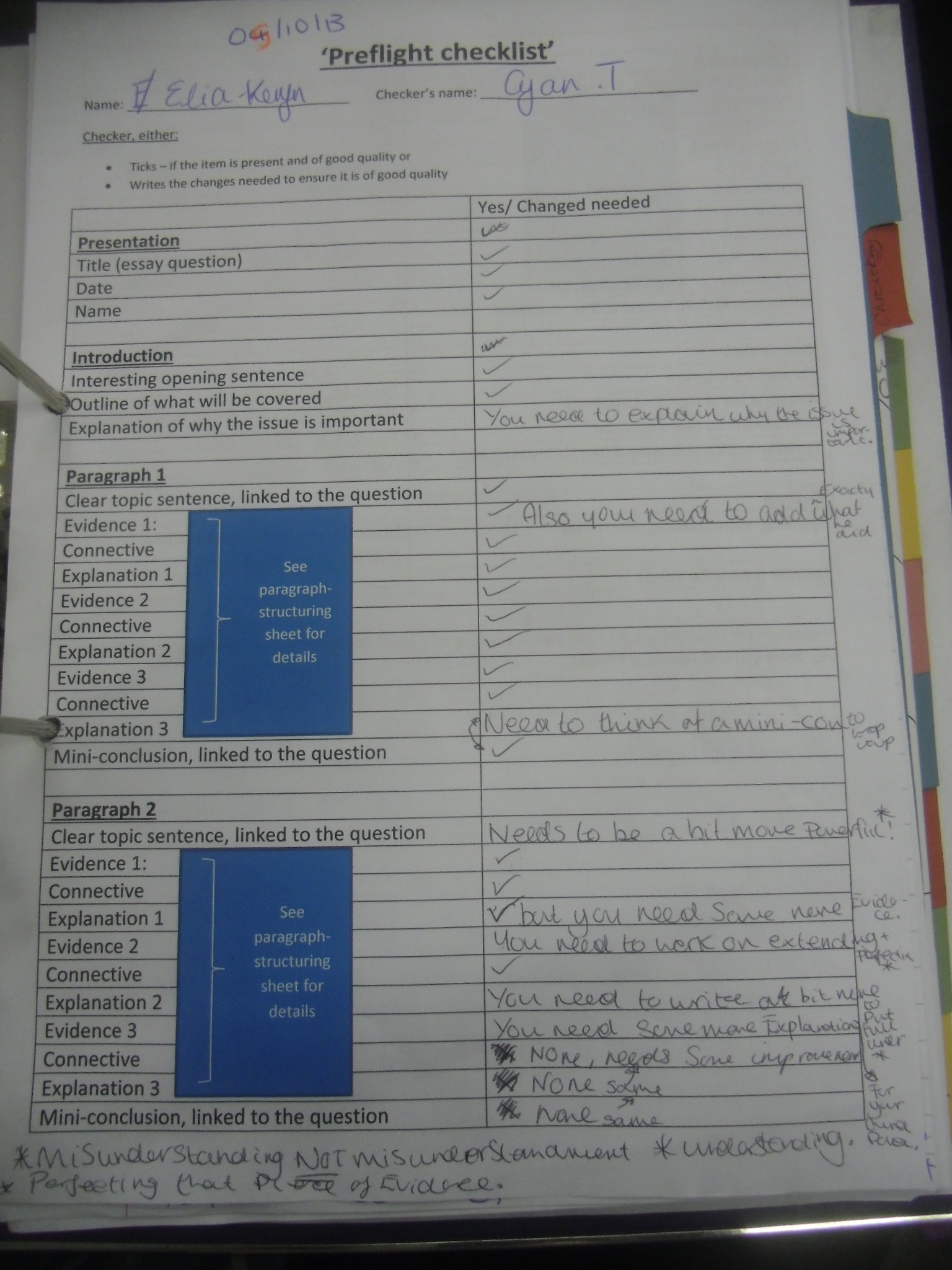A man may take to drink because he feels himself to be a failure, and then fail all the more completely because he drinks. It is rather the same thing that is happening to the English language. It becomes ugly and inaccurate because our thoughts are foolish, but the slovenliness of our language makes it easier for us to have foolish thoughts. The point is that the process is reversible.”
George Orwell, Politics and the English Language
Ron Berger’s vision of crafting beautiful student work inspired me: the process of redrafting and critiquing he describes is powerful, not only because the finished product is so much better, but also because it helps students think more clearly and understand the subject more deeply. Reading An Ethic of Excellence, I promised myself that this year students would complete any piece of extended writing at least three times. This post explores some of the ways I sought to ensure this redrafting was worthwhile, that each draft was better than the last; it also seeks to refine the tools I described in a post some months ago supporting students in essay writing.
Context
My Year 8 students began this year studying a unit designed to remind them why history matters (for reasons I’ve explored here and in ways I’ve discussed here), taking a contemporary problem (Syria) and considering how history can help us to understand it better (how does it inform Britain’s decision on intervention?) Over four lessons, we explored the problem and Syria’s recent past, the consequences of the invasion of Iraq and the reasons for Appeasement in the 1930s. We then began writing essays (in the form of letters to our MP) on the subject.
Planning
I gave students planning process sheets, designed to help them use what they have learned to formulate an essay plan independently. These are little changed from those I have been using for a couple of years – strong on helping students identify topics for paragraphs and marshal evidence, weaker on helping to structure the writing itself. Some students struggled, not having followed all the conceptual leaps (analogising Iraq and Syria, for example) or having forgotten the principles of essay writing from the previous year. Below is the planning sheet and one example of a plan:
I began the process of peer critique by having students examine each others’ plans. The criticisms they made were simple (and fairly uniform – more, better evidence) – but some students appeared to take this point to heart.
Writing
I realised during our Teacher Learning Community that while the planning sheet can be useful in structuring the essay as a whole, it provides insufficient support to students in constructing the essay and the paragraph itself. I wanted to demonstrate how evidence can be connected with explanations; how these sentences in turn should support points and conclusions which link with the overall question. The second version of the result was the sheet below*:
So, while drafting, I encouraged students to have this sheet in front of them – students who struggled with paragraphing I asked to write on a series of these sheets. Some used this to great effect and wrote much more coherent paragraphs; for many, the sheet was insufficiently clear and they wrote what they intended to write anyway around my ‘helpful’ prompts. The effect they can have is shown here:
Preflight checklist
Once they had completed their first drafts, I asked students to use a preflight checklist to examine each others’ work – as a means of offering feedback and an opportunity for the checker to better understand what I’m looking for (for more on this idea, see my previous post). As with the paragraph sheet, I had improved on my previous version of this sheet by focusing more closely on the construction of individual sentences within the essay:
Incorporating this feedback, students then composed a second draft.
Marking
I used codes to mark quickly and place the onus on students to improve their work, a strategy I’ve described before in this post on ‘closing the gap’ marking. The codes I used are:
I used this marking in two different ways:
– ongoing sampling: after each lesson, I chose five essays at random and marked them for the next lesson. This was primarily to help me keep track of how the class were doing and plan for the next lesson, for example, noticing the limited nature of students’ opening sentences, I added a brief activity in the next lesson examining model opening sentences. It also gave those students some additional feedback on which to act.
– marking all final draft essays: and returning them to students to act on feedback (for example, by rewriting one paragraph).
For a (very strong) example of the kind of improvements this led to, compare the two paragraphs below:
I love the way this student has taken the feedback, acted upon it and rewritten the paragraph accordingly. Her first draft is of a high standard, nonetheless, this shows clear growth from one draft to another – something many other students displayed.
Evaluation
Redrafting has a big impact
Tom Sherrington posted recently, discussing a video of Ron Berger’s, which demonstrates the power of redrafting through the evolution of a student’s drawing of a butterfly, far better than I can describe in the process of essay-writing. I would note, however, that this process:
1) Improves quality of work as the example above shows.
2) Builds students’ pride in their work as they realise this is not just something to be done and set aside, it is something to be improved upon. I had expected complaints about the redrafting process – there were none. This may be because I had sold what we were doing very carefully, but I think, more importantly students appreciated the improvement they were seeing in their own work.
3) Increases understanding as students are forced into the true process of history – of returning to the initial evidence in light of new considerations and testing that evidence better. This was most notable with the class which had been least-engaged with the initial four lessons: a second and third visit to the idea of evidence saw them asking some of the good questions which they had not done first time around – understanding and beginning to take on an ethic of excellence.
Questions and problems remain.
I find this strategy exciting – but it is not magic bullet. Questions include:
1) Breadth versus depth. One visitor noted that the essays were great – but equally questioned whether students had done a sufficient quantity of extended writing. I’ve marked a vast quantity of poor quality written work over the years, so I’m quite taken by this, more time-consuming, deeper approach – but there is a balance to be struck and I’m not yet clear where it lies.
2) Time taken versus amount done. Slow-movers and absentees barely (or did not) complete their second drafts… at which point the final product often remained as weak as though I had offered them only an hour in which to complete the essay. Perhaps tighter target-setting for individual students (as to how much they should complete in a certain time) would help them to focus better on completing their drafts.
3) Clarity and modelling. Why do some students not act on the feedback they receive or the models I show them? Most students are keen to do well, so do they simply not understand what I’m asking them to do? I think I need to do more to clarify and model what I expect; in particular to spend more time dissecting examples of good writing early on in the process.
4) How much do we mark – what impact does the marking have? Marking the second draft and asking for a third would, I think, have been far more powerful than marking a final draft. Ideally, I would look at every draft early in the process… so all students have teacher-feedback to improve their work earlier on in the process. Actually, marking five essays between each lesson was already a huge strain on my time, but perhaps I need to consider simpler (and quicker) marking strategies, deployed more often.
5) Time learning versus time writing. There is a case that more time spent on the first four lessons (where we studied the examples used as evidence in the essays) would have made for a better finished product. Equally, there is merit in returning to the topics we have previously studied, with eyes freshened by the task of writing the essay. Another balance to keep in review.
Next steps
Building on these questions, I would like to consider the role of genre in historical writing and teaching this more explicitly – as promoted by Lee Donaghy and consider Joe Kirby and Katie Ashford’s marking strategy – every book, every lesson (links are below).
Conclusion
Entering into this feedback and improvement process is, I believe, to any form of good writing – it is the core of what I did as a student of history and the process of continual redrafting is how I blog (this post, for example, has been gestating for over two months). Yet, previously, I have not given my students the chance to participate fully in the approach to writing which I find creates the best results. This approach – demonstrating and inviting students to pursue an ethic of excellence – offers great dividends; I will certainly be using it again.
* The example here is from one I had used with students regarding the sad death of Alphonse the Camel – who perished that we might undertake better causal reasoning. I’m questioning his utility more recently, but I needed an example and this was what I used. For more, try this video.
Further reading:
Lee Donaghy – on genre in historical writing.
Joe Kirby – on his and Katie Ashford’s solution to too much marking – mark every book, every lesson.
I originally meant this to coincide with October’s blogsync on marking that has an impact – and failed (due to the time taken to redrafting…)
If you want the sheets shown above to play around with, they’re here:
Essay process writing sheet, Paragraph structuring sheet, Preflight checklist
Please let me know what you make of them…








